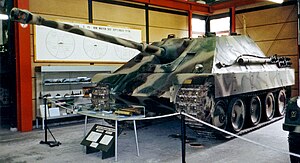
Back ياغدبانثر Arabic Jagdpanther AZ Ягдпантер Bulgarian Jagdpanther BR Jagdpanther Czech Jagdpanther Danish Jagdpanzer V German Jagdpanther Spanish Jagdpanther ET Jagdpanther Finnish
| Jagdpanther | |
|---|---|
 Jagdpanzer V Jagdpanther | |
| Type | Self-propelled anti-tank gun |
| Place of origin | Nazi Germany |
| Service history | |
| In service | 1944–1945 (Nazi Germany) |
| Used by | Nazi Germany |
| Wars | World War II |
| Production history | |
| Produced | 1943–1945 |
| No. built | 413 (+ 12 postwar) |
| Variants | G1, G2 |
| Specifications | |
| Mass | 45.5 t (44.8 long tons; 50.2 short tons) |
| Length | 9.87 m (32 ft 5 in) |
| Width | 3.42 m (11 ft 3 in) |
| Height | 2.71 m (8 ft 11 in) |
| Crew | 5 |
| Armor | 80 mm (3.14 in) frontal 100 mm (3.93 in) mantlet 50 mm side 40 mm rear |
Main armament | 1 × 8.8 cm Pak 43/3 or 43/4 57 rounds |
Secondary armament | 1 × 7.92 mm MG 34 machine gun (600 rounds) |
| Engine | Maybach HL230 P30 (V-12 petrol) 700 PS (690 hp, 515 kW) |
| Power/weight | 15.4 PS (11.3 kW) / tonne |
| Suspension | dual torsion bar |
Operational range | Road: 260 km (160 mi) Cross-country: 130 km (81 mi) |
| Maximum speed | 46 km/h (29 mph) |
The Jagdpanther (German: "hunting Panther"), Sd.Kfz. 173, was a tank destroyer (Jagdpanzer, a self-propelled anti-tank gun) built by Germany during World War II. The Jagdpanther combined the 8.8 cm Pak 43 anti-tank gun, similar to the main gun of the Tiger II, with the armor and suspension of the Panther chassis.[1]
It entered service in 1944 and served on the Eastern and Western Fronts. During the last stages of the war, limited German production resulted in small production numbers, shortage of spare parts, and shortened crew training periods of younger operators.